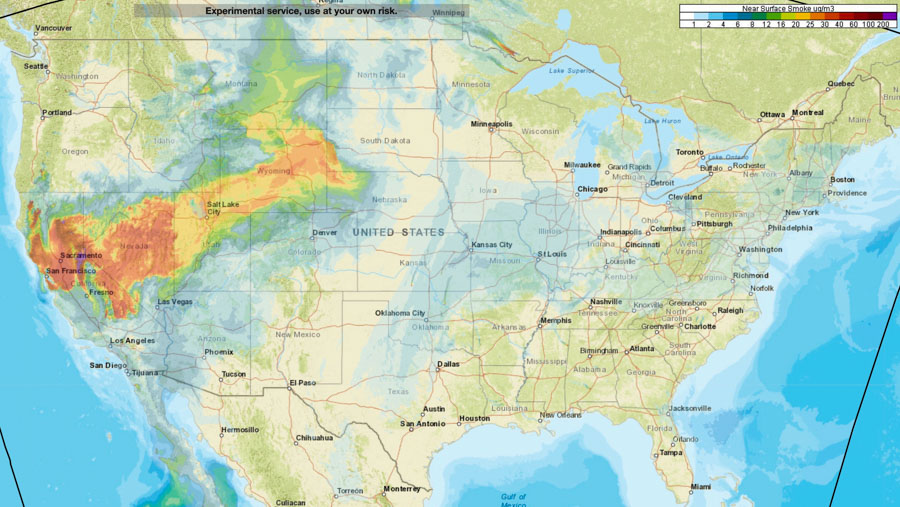8:08 a.m. MDT Oct. 1, 2021

The release of a 438-page study by the US Environmental Protection Agency to compare the smoke impacts from prescribed vs. wildfire is not a ground-breaking event that will change fire management.
Titled, “Comparative Assessment of the Impacts of Prescribed Fire Versus Wildfire (CAIF): A Case Study in the Western U.S.”, the large 28MB .pdf file can be downloaded here.
In January 2020, the Wildland Fire Leadership Council, an intergovernmental committee formed to support the implementation and coordination of Federal Fire Management Policy and chaired by senior leadership in the U.S. Department of Agriculture and Department of the Interior, requested and paid for the EPA to lead an assessment to characterize and compare the smoke impacts of prescribed fire and wildfire under different fire management strategies, including prescribed fire.
They evaluated two fires, the 3,000-acre Timber Crater 6 Fire that occurred in Oregon in 2018 and the 150,000-acre Rough Fire of 2015 in the Sierra NF, Kings Canyon National Park, and Sequoia NF of California. I could not find any indication that the researchers studied a prescribed fire, which usually burn with different fire behaviors than a wildfire.
The poorly edited report is not light reading and is a slog to wade through the hundreds of pages.
Many of the report’s “key insights” will not be a surprise to land managers (or anyone with a little common sense and exposure to fire management). Here are samples from Chapter 9, “Integrated Synthesis”:
- Smaller wildfires produce fewer public health impacts than larger wildfires.
- Convincing the public to evacuate or use air cleaners or HVAC filters to decrease exposure to PM2.5 can decrease public health impacts from smoke.
- If a wildfire spreads into an area previously treated with prescribed fire it can reduce additional spread of the wildfire.
- Smoke plumes that do not intersect with high population areas or last only a few days are less likely to have substantial health impacts than fires affecting larger populations for longer periods.
Update at 3:19 p.m. Oct. 1, 2021:
After publishing the article above, we heard from Bob Yokelson with the Department Chemistry at the University of Montana. He and others have produced data showing the differences between smoke produced by prescribed fires and wildfires. It’s all in their paper, “Aerosol Mass and Optical Properties, Smoke Influence on O3, and High NO3 Production Rates in a Western U.S. City Impacted by Wildfires.”
Here is the passage Mr. Yokelson sent us:
“We stress that there is now more than 1,000 hr of ground‐based data from Missoula, suggesting that a typical PM2.5/CO value for aged wildfire smoke at the surface is about half the value in fresh to moderately aged well‐lofted wildfire plumes (Collier et al., 2016; Garofalo et al., 2019; Liu et al., 2017). One airborne wildfire study by Forrister et al. (2015) at lower latitudes and sampling elevations than the other airborne studies is consistent with the downwind net evaporation we apparently observe in Missoula.
“We also stress that, despite the evidence for PM evaporation during aging, there are strong data discussed next, supporting the idea that wildfires produce more PM than spring or fall prescribed fires on a per fuel burned or per area burned basis. Liu et al. (2017) reported that EFs for PM1.0 (gPM1.0/kg fuel burned) are almost four times higher in wildfires (27.1 ± 6.1) than spring and fall prescribed fires (7.3 ± 4.2; May et al., 2014). Our 2 year average ΔPM2.5/ΔCO ratio in aged wildfire smoke (~0.117) is ~1.7 times higher than implied for aged, fall western montane prescribed fire smoke (~0.07) based on May et al. (2014, 2015), suggesting that a remnant of the difference in initial PM emissions can survive aging. Fuel consumption in spring/fall prescribed fires at the national level is typically 7.2 ± 2.7 Mg ha−1 (Yokelson et al., 1999, 2013) as opposed to 34.6 ± 9.9 Mg ha−1 on wildfires (Campbell et al., 2007; Santín et al., 2015).
Combining the emissions and fuel consumption differences implies that wildfires emit 18 ± 14 times more PM per area burned. Although prescribed fires cannot simply replace all wildfires (Schoennagel et al., 2017; Turner et al., 2019), their potential to reduce the level of wildfire impacts deserves more attention. In addition, incorporating higher wildfire initial emissions and temperature‐dependent, post emission OA evaporation may improve models of wildfire smoke impacts (Nergui et al., 2017).”
Citation:
Selimovic, V., Yokelson, R. J., McMeeking, G. R., & Coefield, S. (2020). Aerosol mass and optical properties, smoke influence on O3, and high NO3 production rates in a western U.S. city impacted by wildfires. Journal of Geophysical Research: Atmospheres, 125, e2020JD032791. https://doi.org/10.1029/2020JD032791










